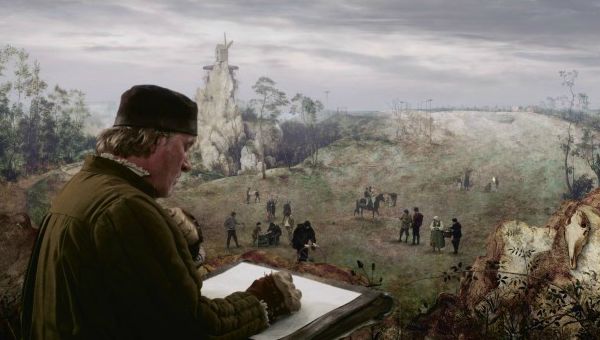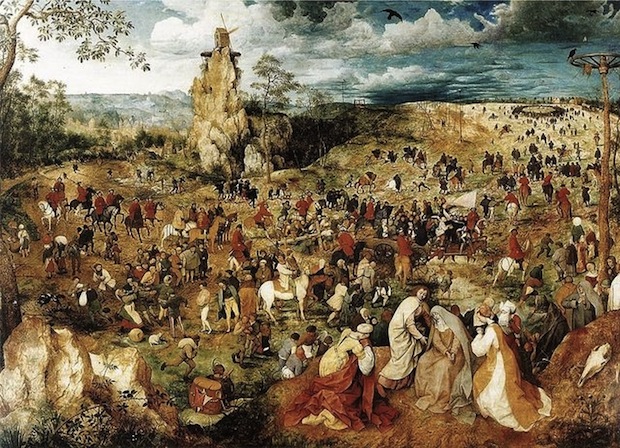How long does it take to look at an artwork? How do you judge how to fully appreciate a sculpture or a painting, to fully appreciate the intention of the artist?
In our fast moving, disposable world the average time we spend looking at the next house we’ll buy is only half an hour, so the chance to evaluate an artwork in the detail afforded by a feature length film nearly four times that length should be greatly appreciated. But in order to allow the audience that opportunity, director Lech Majewski spent over three years fine tuning his unique approach to forming a better understanding of a Dutch renaissance masterpiece, an effort which is apparent in every stylised, sumptuous frame.
The art work that Majewski has deconstructed here is The Procession To Calvary by Flemish artist Peter Bruegel the Elder. The work, the second largest by Bruegel, is a landscape scene featuring around five hundred separate characters. The two key elements of Bruegel’s work are inspired by a couple of verses of Mark’s gospel which refer to Simon of Cyrene being asked to carry the cross of Jesus on the route to Calvary. The first of those elements is the carrying of the cross, but in common with other works of the era the scene is but a small part of the overall landscape. The second is the mill, set on high on a rocky outcrop and intended to signify the presence of God in a less literal fashion than was common in art at the time.
The other source material for Majewski’s film is a study of the painting published in 1996 by art historian Michael Francis Gibson, also published under the title THE MILL AND THE CROSS. Gibson looked at the real world inspiration for Bruegel’s work, as the contemporary political situation which saw religious persecutions and executions taking place on a regular basis. The film sees the painting being constructed by Bruegel, here played by Rutger Hauer, in discussion with the painting’s commissioner Niclaes Jonghelinck (Michael York). Through their eyes we see both the modern day floggings and executions taking place in the name of religion that Jonghelick would have witnessed, as well as the parallels to the historic events of the crucifixion.
the world represented by the painting is brought to life in stunning fashion.
THE MILL AND THE CROSS interweaves a dozen of the individual stories of the five hundred characters in Bruegel’s landscape. Majewski uses a combination of tableaux to represent the selected characters, ranging from those without significant dialogue to the most significant, Mary (Charlotte Rampling). Dialogue in the film serves a dual purpose: scenes between Bruegel and Jonghelinck help to outline Bruegel’s thoughts and his process of composition, but it’s also used to give an insight into the thoughts and moods of the characters. It’s the first of these two that’s the more successful, providing a thorough and effective analysis of the painting’s composition; the character dialogue never quite feels as if it’s captured the mindset of its characters, but Hauer, York and Rampling’s performances are all reasonable enough.
But it’s not the dialogue which makes THE MILL AND THE CROSS stand out, it’s the incredible visuals. Using the three years’ worth of computer graphics which Majewski’s team painstakingly crafted – even to the extent of agonizing over the movement patterns of a computer generated spider and its web seen for just a few seconds on screen – the world represented by the painting is brought to life in stunning fashion. Settling on a visual style for the backgrounds that’s a half-way house between reality and the Bruegel’s oil panel, watching THE MILL AND THE CROSS truly creates the feeling of stepping into another world and Majewski applies the same level of detail and attention to both his close-ups and his wide landscape views.
The other advantage provided by reviewing the painting in this fashion is that Majewski can allow events to play out, rather than simply deconstructing a simple image, and the climax of the film sees the events of the crucifixion play out, the miller looking down at all times and the mill omnipresent in the background. What Majewski has attempted at a personal level is to find a greater personal understanding of this particular artwork: in doing so, he not only succeeds in getting to the heart of what Bruegel’s intent was with his epic painting, but also vividly and memorably brings it to life.
httpvh://youtu.be/FIJZgJuqoUI
THE MILL AND THE CROSS screens on 11 September at 13.30 at APH


